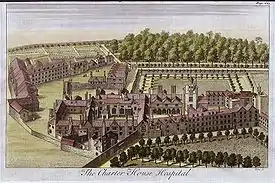Henry Levett
Dr. Henry Levett (1668–1725) was an early English physician who wrote a pioneering tract on the treatment of smallpox and served as chief physician at London Charterhouse.

Life
Levett was a pupil at Charterhouse School, and then attended Magdalen College, Oxford, in 1686 at age 17. He graduated with an M.D. from Oxford in 1699.[1] He settled in London, where he was elected physician to St. Bartholomew's Hospital in 1707 and became physician to the nearby Charterhouse in 1713, becoming an early pioneer of the connection between the two institutions. Levett was also a ground-breaking doctor. In 1710 he wrote a paper at the request of Dr. John Freind urging the user of 'cathartics' (purgatives) in treating smallpox. Levett had made a study of two cases, and refers to those in his treatise, written in Latin, which Dr. Freind reprinted in its entirety in his collected works of 1733.[2]
Henry Levett is also believed have authored the short memoir of Dr. William Wagstaffe, a well-known physician of the age. Levett's work on Wagstaffe, entitled 'Character,' which was prefixed to the Wagstaffe's 'Miscellaneous Works' published in 1725. In it, the author of the sketch on Wagstaffe (presumably Levett) is referred to as "an eminent Physician, no less valued for his skill in his profession, which he showed in several useful treatises, than admired for his Wit and Facetiousness in Conversation."[3]
Levett and Freind were both friends and correspondents of the English antiquarian Thomas Hearne, who frequently corresponded with the two physicians about his health and other topics.[4]
Levett rebuilt at his own expense the school physician's home, the home extending beside and beyond the great gate in Charterhouse Square.[5] Levett resided in the home until his death,[6] and he decorated it with oak panelling and elaborate carving. Levett played a major role in shaping the early history of the Charterhouse. He also served as treasurer to the Royal College of Physicians. In that capacity Levett purchased 10 candlesticks and a pair of snuffers and stands from the goldsmith Matthew Cooper that are still in the collection of the Royal College of Physicians.
Levett is buried at the foot of the altar in the chapel at Charterhouse, where there is a classical monument in his honor.[7] The grave contains an inscription in Latin as well as Levett's coat-of-arms.[8] Dr. Henry Levett was the son of William Levett Esq. of Swindon and Savernake Forest,[9] Wiltshire, courtier to King Charles I of England, who accompanied the King during his imprisonment and to his eventual execution.[10]
Henry Levett died on 2 July 1725, aged 56.[11] His widow remarried the school's headmaster Andrew Tooke.
References
- Charles William Boase, Publications by Oxford Historical Society, Registrum Collegii Exoniensis, Exeter College, Oxford, Clarendon Press, Oxford, 1894
- The Roll of the Royal College of Physicians of London, volume II, Royal College of Physicians, William Munk M.D., London, 1861
- . Dictionary of National Biography. London: Smith, Elder & Co. 1885–1900.
- Remarks and Collections of Thomas Hearne, Thomas Hearne, Charles Edward Doble, David Watson Rannie, Herbert Edward Salter, Oxford HIstorical Society, Clarendon Press, Oxford, 1902
- The Carthusian By Charterhouse, Charterhouse (London, England), 1837
- Medical Old Carthusians: Their Lives and Times, Dr. Eric Webb, 1998
- The Carthusian: A Miscellany in Prose and Verse, By Charterhouse, S. Walker, London, 1837
- Henry Levett grave inscription, The Registers and Monumental Inscriptions of Charterhouse Chapel, The Publications of the Harleian Society, Francis Collins M.D. (ed.), London, 1892
- Dr. Henry Levett inherited Levett's Farm in Savernake Forest from his father, and eventually passed it to family heirs.
- The Roll of the Royal College of Physicians of London, Vol. II, Dr. William Munk, Royal College of Physicians, 1878
- Centre for Metropolitan History, Old and New London: Vol. II, Walter Thornbury, 1879, British History Online